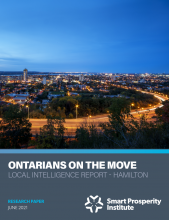A recent report by Oxford Economics placed Hamilton as the third-least affordable city in North America when it comes to housing. Only Toronto and Vancouver were listed as less affordable, whereas U.S. communities such as San Jose, New York City, and Los Angeles, famous for their high housing costs, were found to be more affordable (Hristova, 2021). Our rough estimate is that, on net, 13,000-15,000 residents left the Hamilton community between 2015 and 2020 due to a lack of housing.
To understand how we got here, it is important to understand the following trends that were occurring before the pandemic:
- Starting in 2015, the Hamilton Census Metropolitan Area (CMA), like much of Ontario, experienced an increased influx of young people from international sources in search of educational and job opportunities. The population of Ontario grew by 1,000,000 people between 2015 to 2020, whereas it had increased by less than 600,000 in the previous five years.
- Home building in Toronto, which experienced the highest levels of population increases from international sources, was unable to keep up with the population growth, creating housing shortages and high home prices.
- These high housing prices in Toronto caused young families to migrate to nearby communities in Ontario, including Hamilton, in search of housing they can afford, a process known as ‘drive until you qualify’.
- Home building of all types and tenures in Hamilton was unable to keep up with the population growth from both international sources and young families moving from Toronto, creating housing shortages and high home prices in the Hamilton market.
- Young families in Hamilton began to get priced out of their own market, and ‘drove until they qualified’, to nearby cities such as St. Catharines and Brantford, causing a population boom in those communities. This is known as the ‘musical chairs effect’.
- This presents an urban housing challenge for Hamilton CMA (Hamilton, Burlington and Grimsby) and could also potentially impact its ability to attract talent, as parents of young children who move into other communities may not be willing to commute back to Hamilton for work.
- For the individuals that are willing to commute back to Hamilton to work, a large volume of intercity commuters puts strain on our road infrastructure and leads to higher GHG emissions.
The factors that led to these housing shortages are not going away. In fact, they are likely to accelerate when the pandemic ends. The three communities that comprise the Hamilton CMA have a decision to make: Will they ensure enough housing gets built for a growing Golden Horseshoe population or will they continue the path of unaffordable housing and an exodus of young families from the community.



